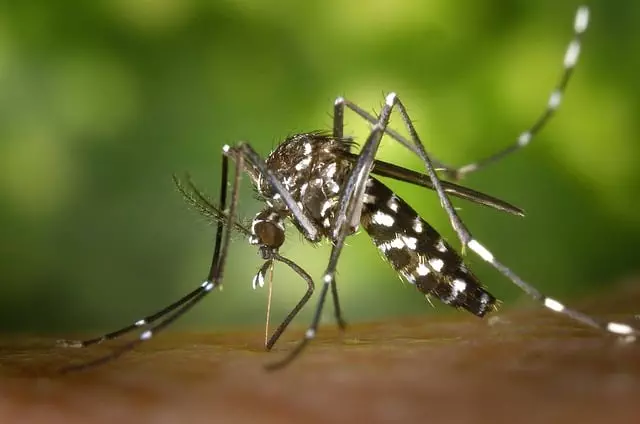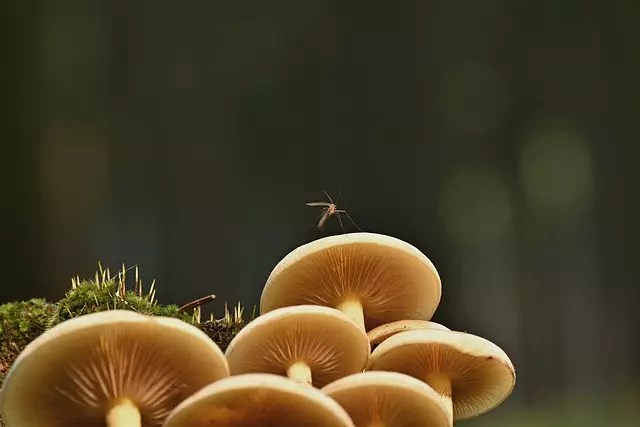Mosquitoes, beyond being a nuisance, pose significant health risks by transmitting diseases. Effective mosquito control involves understanding their behaviors: breeding in standing water, seeking dark, secluded areas for rest, and feeding/mating at dawn and dusk. Key strategies include identifying and treating breeding sites, using repellents (natural or chemical), installing screens, and maintaining landscapes to reduce breeding grounds. Natural repellents like citronella and neem oil offer eco-friendly alternatives. Chemical options, such as DEET, picaridin, and lemon eucalyptus oil, should be used responsibly, especially around children and pets. Environmentally sustainable methods include eliminating standing water, introducing fish predators, and restoring natural habitats. For outdoor activities, pack repellent, wear protective clothing, choose campsites away from water sources, and use mosquito nets or devices. Technology, like smart sensors and apps, revolutionizes control efforts by providing real-time data and personalized guidance. Community initiatives, clean-up drives, and awareness campaigns significantly enhance mosquito control through collective action and resource sharing for more comprehensive and sustainable solutions.
Mosquitoes are more than just a nuisance; they pose significant health risks, transmitting diseases that affect millions globally. Understanding these insects’ behavior and breeding patterns is crucial for effective mosquito control. This article provides an all-encompassing guide to preventing and protecting against mosquitoes, exploring natural and chemical repellents, environmental strategies, and innovative technologies. From identifying common entry points to community initiatives, learn how to combat these pests in various settings, ensuring safer outdoor experiences.
Understanding Mosquitoes: Behavior and Breeding Patterns

Mosquitoes are more than just a nuisance; they are intricate creatures with distinct behaviors and breeding patterns that play a significant role in their ability to transmit diseases. Understanding these patterns is crucial for effective mosquito control. These insects breed in standing water, making areas with stagnant water ideal habitats for them. They go through several life stages, from egg to larva to pupa before emerging as adults. During the day, mosquitoes rest in dark, secluded places, while they feed on hosts and mate at dawn and dusk. This knowledge is essential for developing strategies to disrupt their breeding cycles and reduce their population.
By identifying their preferred breeding sites and understanding their activity patterns, individuals can implement targeted mosquito control measures. Removing or treating standing water sources around homes, such as buckets, flower pots, and clogged gutters, significantly reduces breeding opportunities. Additionally, using mosquito repellents and installing screens on windows and doors can hinder their access to humans, thereby minimizing the risk of disease transmission.
Identifying Common Entry Points for Mosquitos in Homes and Outdoor Spaces

Mosquitoes are adept at finding their way into homes and outdoor areas, often through seemingly small openings or gaps. Identifying these common entry points is a crucial step in effective mosquito control. In residential settings, cracks around doors, windows with loose fitting screens, and vents leading to attics or basements can all provide easy access for these pests. Even small gaps under doors or around utility pipes can allow mosquitoes to enter and breed.
Outdoor spaces also offer numerous opportunities for mosquito infiltration, including unkempt landscapes where standing water collects in flower pots, birdbaths, or discarded containers. Gutter systems with blockages and poorly maintained swimming pools or ponds are additional magnets for mosquitoes seeking breeding grounds. Recognizing these entry points is the first step towards implementing strategies to keep mosquitoes at bay, ensuring a more comfortable and healthier environment.
Natural Repellents and Plant-Based Solutions for Mosquito Control

Natural Repellents and Plant-Based Solutions for Mosquito Control
In the quest for effective mosquito control, turning to nature offers a plethora of options. Certain plants and their extracts have been found to act as powerful natural repellents, providing an eco-friendly alternative to synthetic chemicals. These plant-based solutions not only deter mosquitoes but also pose fewer health risks to humans and the environment. Compounds like citronella, found in lemongrass, and neem oil from the neem tree, have long been used for their insecticidal properties.
Beyond these well-known plants, various other aromatic herbs and essential oils exhibit exceptional mosquito-repelling abilities. For instance, lavender, peppermint, and eucalyptus oils are known to keep mosquitoes at bay naturally. Incorporating these natural repellents into everyday life is easier than you think—from using scented candles or diffusing oils to planting herb gardens or utilizing herbal sprays. By embracing these plant-based solutions, individuals can actively contribute to a more sustainable approach to mosquito control while enjoying the added benefits of nature’s healing powers.
Chemical Repellents and Pesticides: Effectiveness and Safety Measures

Chemical repellents and pesticides have long been a go-to for mosquito control, offering a quick and apparent solution to these irritating pests. However, their effectiveness varies greatly. DEET, a common active ingredient in insect repellents, is widely recognized for its potency against mosquitoes. Yet, other chemicals like picaridin and oil of lemon eucalyptus also show promise, providing longer-lasting protection without the potential health risks associated with DEET.
While these products can be effective, safety measures must be taken into account. It’s crucial to follow application instructions carefully, especially when using around children and pets. Some repellents may cause skin irritation or allergic reactions in sensitive individuals. Additionally, not all pesticides are created equal; some may have harmful environmental impacts if not disposed of properly. Choosing eco-friendly options and practicing responsible use can help mitigate these risks, ensuring a balance between mosquito control and overall well-being.
Environmental Strategies for Reducing Mosquito Populations

Environmental strategies play a crucial role in mosquito control, offering sustainable and eco-friendly solutions for reducing their populations. One effective method is eliminating standing water, as mosquitoes breed in stagnant water bodies like buckets, tire tracks, or clogs in drainage systems. Regularly emptying containers, cleaning bird baths, and ensuring proper drainage can significantly curb mosquito breeding grounds. Additionally, implementing natural predators and parasites can help keep mosquito numbers in check. For instance, introducing fish that feed on mosquito larvae into ponds or water features can be an organic way to manage their population.
Planting certain herbs and flowers known for their mosquito-repelling properties is another environmental strategy. Citronella grass, lavender, marigolds, and basil are popular choices, as their scents deter mosquitoes from landing and feeding. Landscaping with these plants around homes or public spaces can create a natural barrier against mosquito bites. Moreover, preserving and restoring natural habitats like wetlands and marshes is vital, as these ecosystems serve as natural mosquito control measures by providing habitat for predators and absorbing excess water, thus reducing breeding sites.
Preventative Measures for Specific Activities: Camping, Travel, and Outdoor Events

When planning outdoor adventures like camping, traveling, or attending events, taking precautions against mosquitoes is essential for an enjoyable experience. Before heading outdoors, pack mosquito repellent containing DEET, picaridin, or oil of lemon eucalyptus to create a protective barrier on exposed skin. Long-sleeved clothing and pants are also beneficial, especially during dawn and dusk when mosquitoes are most active.
For camping trips, set up your campsite away from bodies of water, as mosquitoes breed in stagnant water. Use mosquito nets over beds or sleeping bags for added protection while you sleep. Consider burning citronella candles or using other mosquito control devices to deter them from nearby resting areas.
The Role of Technology in Modern Mosquito Control Methods

In today’s digital era, technology plays a pivotal role in modern mosquito control methods, revolutionizing the way we combat these pesky insects. From smart sensors to advanced apps, innovative tools are helping communities and individuals navigate the challenge of mosquito prevention. These technologies offer precise and data-driven solutions, enabling efficient monitoring and targeted interventions. For instance, smart traps equipped with sensors can detect and attract mosquitoes, providing real-time data on local populations and helping to identify high-risk areas.
Additionally, mobile apps designed for mosquito control offer users personalized guidance and tools. These apps may include features like geographic location-based warnings, tips on reducing breeding grounds, and even community reporting systems where residents can share information about mosquito activity. This integration of technology into mosquito control methods not only enhances protection but also fosters a more proactive and informed approach to managing these vectors of disease transmission.
Community Initiatives and Collaboration for Effective Mosquito Management

Community initiatives and collaboration play a pivotal role in effective mosquito management. By joining forces, local communities can significantly enhance mosquito control efforts. This includes organized clean-up drives to eliminate standing water—a breeding ground for mosquitoes—and community-led awareness campaigns that educate residents on preventive measures like using insect repellents and securing outdoor spaces. Such collaborative actions not only reduce mosquito populations but also foster a sense of collective responsibility for public health.
Additionally, these initiatives facilitate the sharing of resources and expertise. Local governments, non-profit organizations, and community leaders can work together to implement innovative solutions like biological control methods (using natural predators) and targeted spraying campaigns. This coordinated approach ensures more comprehensive and sustainable mosquito control, ultimately improving the quality of life for residents in mosquito-prone areas.
